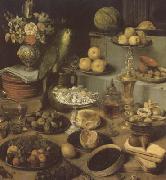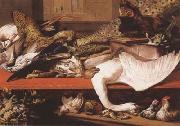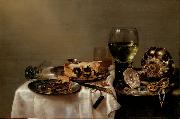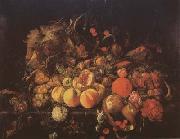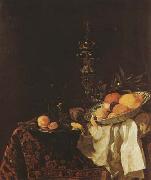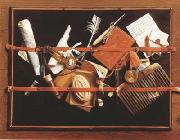Wholesale Oil Painting Reproductions No Minimum and Door to Door! |
|||||||||||
|
|
|||||||||||

|
|||||||||||
|
|
|
||||||||
All Georg Flegel Oil Paintings |
||||||||
|
|
||||||||
|
|
||||||||
|
Artist Introduction: 1566-1638
Georg Flegel Location
German painter. He was the son of a shoemaker, and not being a Roman Catholic, probably moved to Vienna after 1580, when the Counter-Reformation began to take effect in Olmetz. In Vienna he became the assistant of Lucas van Valckenborch I, whom he subsequently followed to Frankfurt, then an important centre for art dealing and publishing. He filled in staffage in van Valckenborch pictures of the seasons and portraits, inserting fruit, table utensils and flowers as still-life set pieces. His faithful reproduction of flowers and fruit drew on watercolours by Derer, still-life painters from the Netherlands living in Frankfurt, and botanical and zoological illustrations by Joris Hoefnagel, Pieter van der Borcht IV and Carolus Clusius (1525-1609) then being published in Frankfurt. |
||||||||
|
|
||||||||
|
Still Life (mk08) Painting ID:: 21611 |
Oil on copper
78x67cm
Munich,Bayerische Staatsgemalde-summlungen,Alte Pinakothek |
|||||||
Height Width |
INS/CM Quality |
|||||||
|
X |
| |||||||
|
|
||||||||
All SNYDERS, Frans Oil Paintings |
||||||||
|
|
||||||||
|
|
||||||||
|
Artist Introduction: Flemish Baroque Era Painter, 1579-1657
Flemish painter and draughtsman, active also in Italy. He was the progenitor of Flemish Baroque still-life and animal painting. He worked intensively for about 50 years, producing an enormous body of works, of which more than 300 paintings survive , along with some oil sketches and about 100 drawings. |
||||||||
|
|
||||||||
|
|
Still Life (mk08) Painting ID:: 21713 |
1614
Oil on canvas
156x218cm
Cologne,Wallraf-Richartz-Museum |
||||||
Height Width |
INS/CM Quality |
|||||||
|
X |
| |||||||
|
|
||||||||
All HEDA, Willem Claesz. Oil Paintings |
||||||||
|
|
||||||||
|
|
||||||||
|
Artist Introduction: Dutch painter (b. 1594, Haarlem, d. 1680, Haarlem).
Dutch still-life painter. His excellent studies of tables laden with food, called ontbijt still life, are seen in many important European galleries. They are characterized by delicate lighting effects and somber colors. |
||||||||
|
|
||||||||
|
|
Still Life (mk08) Painting ID:: 21720 |
Oil on panel
54x82cm
Dresden,Gemaldegalerie Alte Meister |
||||||
Height Width |
INS/CM Quality |
|||||||
|
X |
| |||||||
|
|
||||||||
All Jan Davidsz. de Heem Oil Paintings |
||||||||
|
|
||||||||
|
|
||||||||
|
Artist Introduction: stilllife masters, Dutch Baroque Era Painter, 1606-C.1683 |
||||||||
|
|
||||||||
|
|
Still Life (mk08) Painting ID:: 21754 |
Oil on panel.
55.8x73.5cm
Gent,Museum voor Schone Kunsten |
||||||
Height Width |
INS/CM Quality |
|||||||
|
X |
| |||||||
|
|
||||||||
All Willem Kalf Oil Paintings |
||||||||
|
|
||||||||
|
|
||||||||
|
Artist Introduction: 1619-1693
Dutch
Willem Kalf Galleries
Willem Kalf was born in Rotterdam, in 1619. He was previously thought to have been born in 1622, but H. E. van Gelder??s important archival research has established the painter??s correct place and date of birth. Kalf was born into a prosperous patrician family in Rotterdam, where his father, a cloth merchant, held municipal posts as well. In the late 1630s, Willem Kalf travelled to Paris and spent time in the circle of the Flemish artists in Saint-Germain-des-Pr??s, Paris. In Paris he painted mainly small-scale rustic interiors and still-lifes. Kalf??s rustic interiors are typically dominated by groups of vegetables, buckets, pots and pans, which he arranged as a still-life in the foreground (e.g. Kitchen Still-life, Dresden, Gemäldegal; Alte Meister). Figures usually appeared only in the blurred obscurity of the background. Though painted in Paris, those pictures belong to a pictorial tradition practised primarily in Flanders in the early 17th century, by such artists as David Teniers the Younger. The only indication of the French origin of the paintings are a few objects that Flemish exponents of the same genre would not have pictured in their works. Kalf??s rustic interiors had a large influence on French art in the circle of the Le Nain brothers. The semi-monochrome still-lifes which Kalf created in Paris form a link to the banketjes or 'little banquet pieces' painted by such Dutch artists as Pieter Claesz, Willem Claeszoon Heda and others in the 1630s. During the 1640s, Kalf further developed the banketje into a novel form of sumptuous and ornate still-life (known as pronkstilleven), depicting rich groupings of gold and silver vessels. Like other still-lifes of this period, these paintings were usually expressing vanitas allegories. |
||||||||
|
|
||||||||
|
|
Still Life (mk08) Painting ID:: 21786 |
C.1653/54
Oil on canvas
105x87.5cm
St Petersburg,Hermitage |
||||||
Height Width |
INS/CM Quality |
|||||||
|
X |
| |||||||
|
|
||||||||
All HOOGSTRATEN, Samuel van Oil Paintings |
||||||||
|
|
||||||||
|
|
||||||||
|
Artist Introduction: Dutch Baroque Era Painter, 1627-1678
Dutch painter, draughtsman, engraver and writer. His multi-faceted art and career testify amply to the unflagging ambition attributed to him as early as 1718 by his pupil and first biographer, Arnold Houbraken. During his lifetime van Hoogstraten was recognized as a painter, poet, man of letters, sometime courtier and prominent citizen of his native city of Dordrecht, where he served for several years as an official of the Mint of Holland. Today he is remembered not only as a pupil and early critic of Rembrandt, but also as a versatile artist in his own right. His diverse oeuvre consists of paintings, drawings and prints whose subjects range from conventional portraits, histories and genre pictures to illusionistic experiments with trompe-l'oeil still-lifes, architectural perspectives and perspective boxes. |
||||||||
|
|
||||||||
|
|
Still Life (mk08) Painting ID:: 21799 |
c.1666-1668
Oil on canvas,
63x79cm
Karlsruhe,Staatliche Kunsthalle |
||||||
Height Width |
INS/CM Quality |
|||||||
|
X |
| |||||||
|
|
||||||||
|
Prev Next
|
||||||||
|
|
||||||||
|
Related Paintings to HOOGSTRATEN, Samuel van :. |
||||||||
|
|
||||||||
|
CONTACT US |
